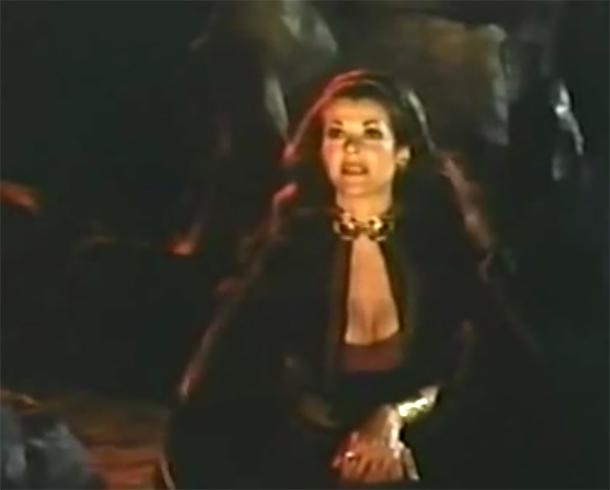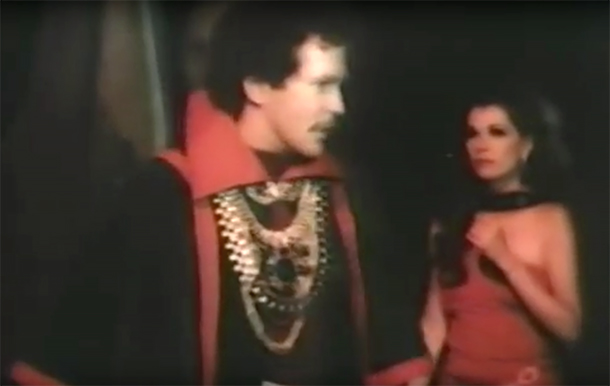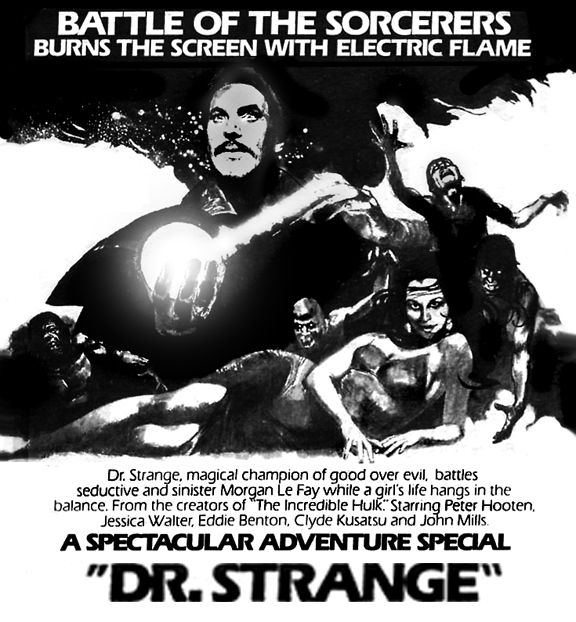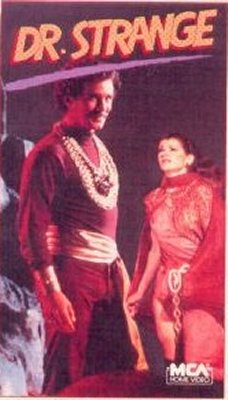Marvel Studios Countdown: Looking Back at 1978's Cheesy Doctor Strange Movie

“There is a barrier that separates the known from the unknown. Beyond this threshold lies a battleground, where forces of good and evil are in eternal conflict. The fate of mankind hangs in the balance and awaits the outcome. In every age and time, some of us are called upon to join the battle…Dr. Strange.”
Thus begins the first Dr. Strange live-action movie, a noble-but-forgotten attempt to get the Sorcerer Supreme out of the pages of Marvel Comics and onto TV screens across the U.S. We’re getting a do-over in 2016, here all these years later, as part of the fabric of the Marvel Cinematic Universe and studded with an all-star cast (including Benedict Cumberbatch as the doctor). Meanwhile, the original version has grown increasingly difficult to see for yourself. The last official VHS release was in 1995, and the film has fallen out of rotation on cable.
Even those who grew up in the heydey of CBS’s Marvel TV productions like The Incredible Hulk and the less popular Amazing Spider-Man have trouble recalling the details of Dr. Strange. One oft-repeated anecdote is that it was trounced in the ratings by Roots (Roots aired in Jaunary 1977; Dr. Strange in September 1978). Still others confuse 1992’s Doctor Mordrid (starring Jeffrey Combs as a Stephen Strange knock-off) for the original Dr. Strange film (Doctor Mordrid was reworked from a Dr. Strange film treatment by B-movie mavens Charles and Albert Band).
Looking at the film now, it’s curious how many elements of Dr. Strange come right over from the comics, especially looking at his live-action peers – Spider-Man didn’t even get to talk on his show and Hulk’s fights were mostly with brick walls and car bumpers. Here, we get Strange as the cocky surgeon put on the path to becoming Sorcerer Supreme after mystic battles on the astral plane. Wong, Clea, The Ancient One, The Nameless One all make appearances, and the demons Asmodeus and Balzeroth are brought to life on a TV budget. Before you get too excited, these superheroic bits are just a fraction of a much more dry movie experience.
The film opens with Morgan LeFay (Arrested Development‘s Jessica Walter) being charged by the Nameless One to defeat the current Sorcerer Supreme (John Mills as Thomas Lindmer) in just three days. LeFay possesses a young woman (Clea, played by 80’s TV and movie staple Anne-Marie Martin) and manipulates her into shoving Lindmer off an overpass.
Shockingly, Lindmer survives. Clea returns home in a fog, reliving the attempted murder by in her dreams. LeFay tracks down Clea to her home, causing a dazed Clea to run out into the street where she’s almost run down by a cab. The cabbie takes her to the hospital where Dr. Stephen Strange (Peter Hooten) works. LeFay follows and spots Strange’s ring, a mystic artifact that’s a total secret to Stephen Strange.

Strange argues with his hospital supervisors over the best treatment for their new Jane Doe, who is suffering from terrible nightmares. Strange wants to keep her awake, but the hospital, against Strange’s advice, induces sleep with heavy sedatives. At this point, Lindmer uses sorcery to get into the hospital and into a one-on-one meeting with Strange, where he tells him that the woman’s name is Clea Lake and that her soul is currently being drawn into the high astral plane. The film isn’t big on details like “how does he know this?” but here we are anyway.
Lindmer intimates that Strange could help Clea if he was truly willing, and Strange, though a skeptic, feels the magical bond between Lindmer and himself. After an attempt on his life by Morgan LeFay (a bus almost runs him over out of nowhere), he seeks out Lindmer. Lindmer, it seems, knew Strange’s father and the ring Strange wears was passed on through his family as a mystical totem. Strange will need to rely on the artifact and more if he’s to enter the astral plane and bring Clea back.
In the astral plane, which looks a lot like classic Dr. Who opening credits, Dr. Strange fights Belzeroth (“In the name of Ryal, Scourge of Demons, I command you – be gone!”) and retrieves Clea pretty handily. Morgan blames her failure on lust, “I am still a woman and the man attracted me. I would feel the warmth of a man’s arms again after all these years alone.” The Nameless One ain’t down with that. He tells Morgan she has another chance to try again or he’ll make sure she’s old and barren until the end of time.
Strange and Clea hit it off pretty well back on the Earthly plane, and Strange turns down the opportunity to study under Lindmer. As a doctor, he feels he can not allow himself to believe the unbelievable things he’s seen. On his way out, Strange lets a black cat into Lindmer’s house, and you can probably see where that’s going. The cat transforms into Morgan, who conjures Asmodeus to take Lindmer to the astral plane. Wong (Clyde Kusatsu) gets a mystic bolt fight scene with LeFay, but she proves more powerful.
LeFay, not content to leave well enough alone, appears at Clea’s apartment and transports her and Dr. Strange back to the astral plane (bad plan, really). She tries to seduce him into taking off the ring by giving him a costume very close to the one we know from the comics and then getting frisky in a big astral bed. She has the upper hand until she decides to show Strange Lindmer’s captured body. Strange snaps out of it and uses his ring to channel the mystic energy to defeat LeFay and return his friends to Earth.
The Nameless One keeps good on his promise to turn LeFay into an old crone and Dr. Strange finally decides to study the mystic arts. After a brief communion with a glowing light known as The Ancient One, Strange gains an all-new (and not as good) costume and the remaining mystic energy of Lindmer. Wong likens Strange to a child with a loaded gun and makes himself available to assist Strange with his tutelage on the path to becoming Sorcerer Supreme.

I don’t know how you go back to a day job after all that, but Strange does. Doctor’s gotta doctor. The film has a few baffling codas stacked on top of each other, including the news interviewing a restored Morgan LeFay, who’s promoting the “LeFay Method” which “unlocks the hidden potential within you.” Clea’s response? “This is really dumb.” Clea chalks everything – the attempted murder, the hospital stay, the journey to the astral plane on demonic horseback – up to studying too hard. Strange doesn’t correct her. Instead, he walks past a street magician where he turns the magician’s intended trick into a dove. Dumb, indeed.
As a film, it’s barely diverting. The astral plane bits are hokey for the most part, though punctuated with little moments of cool, like The Nameless One or Asmodeus. Large swaths of the story are spent in the hospital with Strange being treated like he’s barely competent by the other hospital staff. There are tidbits of characterization (Strange is horny in that oh-so-70’s way), but the production is pretty bone dry for something that should be memorably gonzo.
You can see where they might’ve gone, week after week, with Morgan LeFay showing up to deceive some unsuspecting someone, and Dr. Strange trying to learn new tricks to keep up with her antics. Is that a compelling television show? It’s barely a compelling pilot. On the plus side, Walter is the only actor on screen who seems to have the right approach to the material here. She’s about an inch away from camp villainy, and Hooten looks like a stiff in comparison.
It’s a curious pilot, from a moment in time when Marvel didn’t turn everything it touched into gold, but ultimately Dr. Strange is for completists only. The plot holes, sleepy performances, and cheesy effects are just too big to forgive. Actually, on second thought, we forgive the cheesy effects. We don’t want to see them executed like this in the new Doctor Strange film, but they kept us awake in what was otherwise a snoozer of a Marvel movie.

Doctor Strange, a Scott Derrickson film starring Benedict Cumberbatch and Rachel McAdams, opens November 4. There are 297 days until release.
This entry passed through the Full-Text RSS service – if this is your content and you’re reading it on someone else’s site, please read the FAQ at fivefilters.org/content-only/faq.php#publishers.





